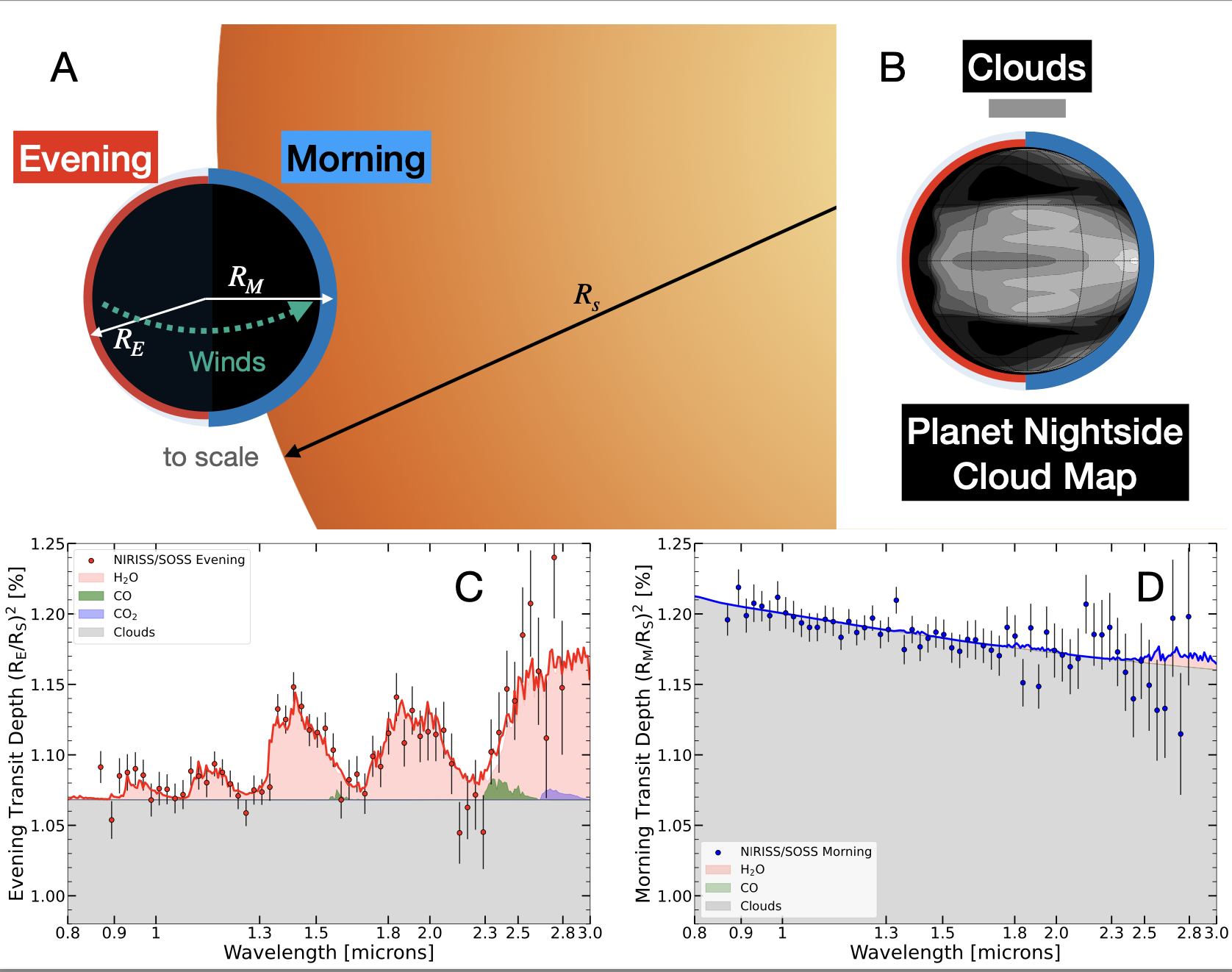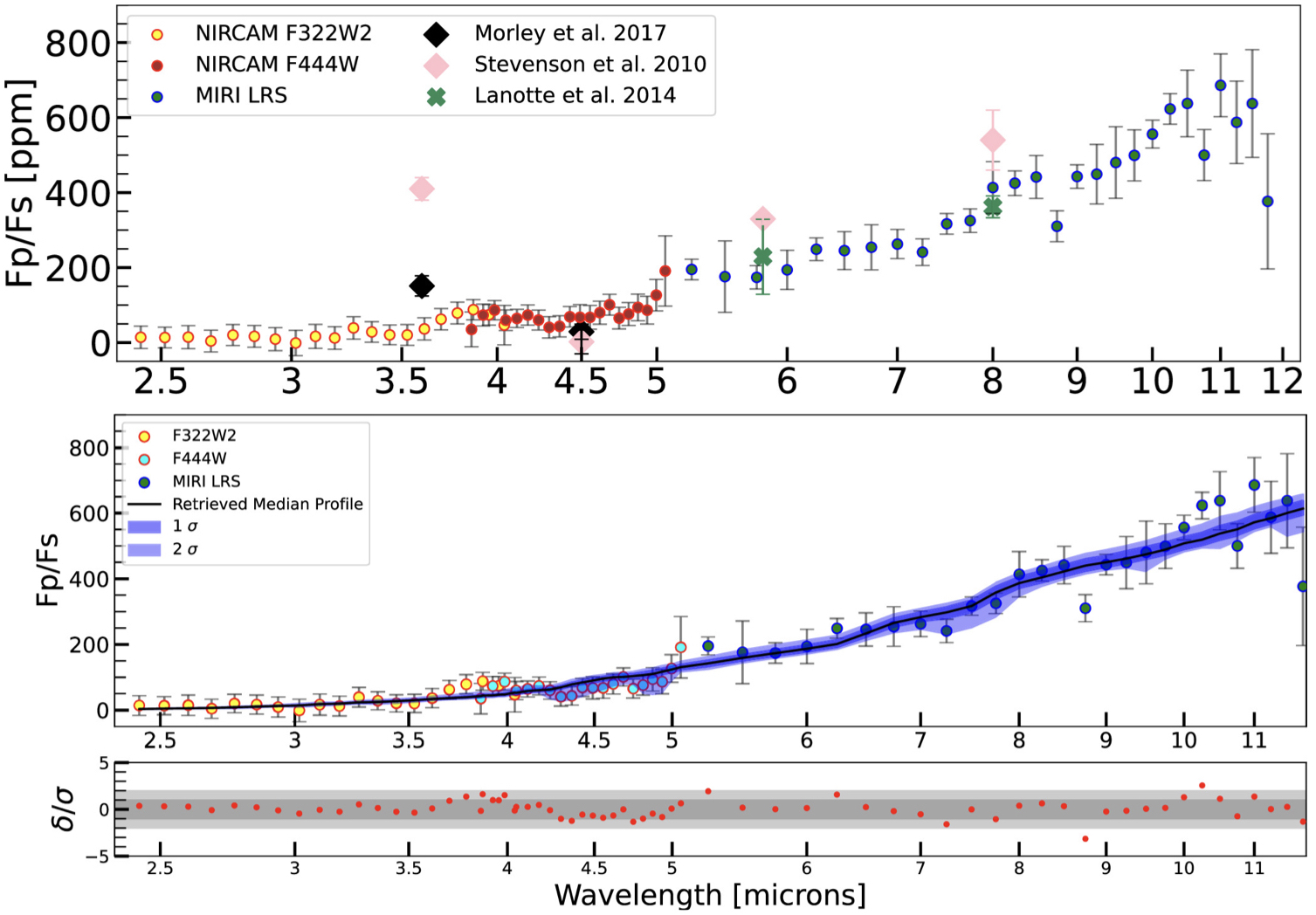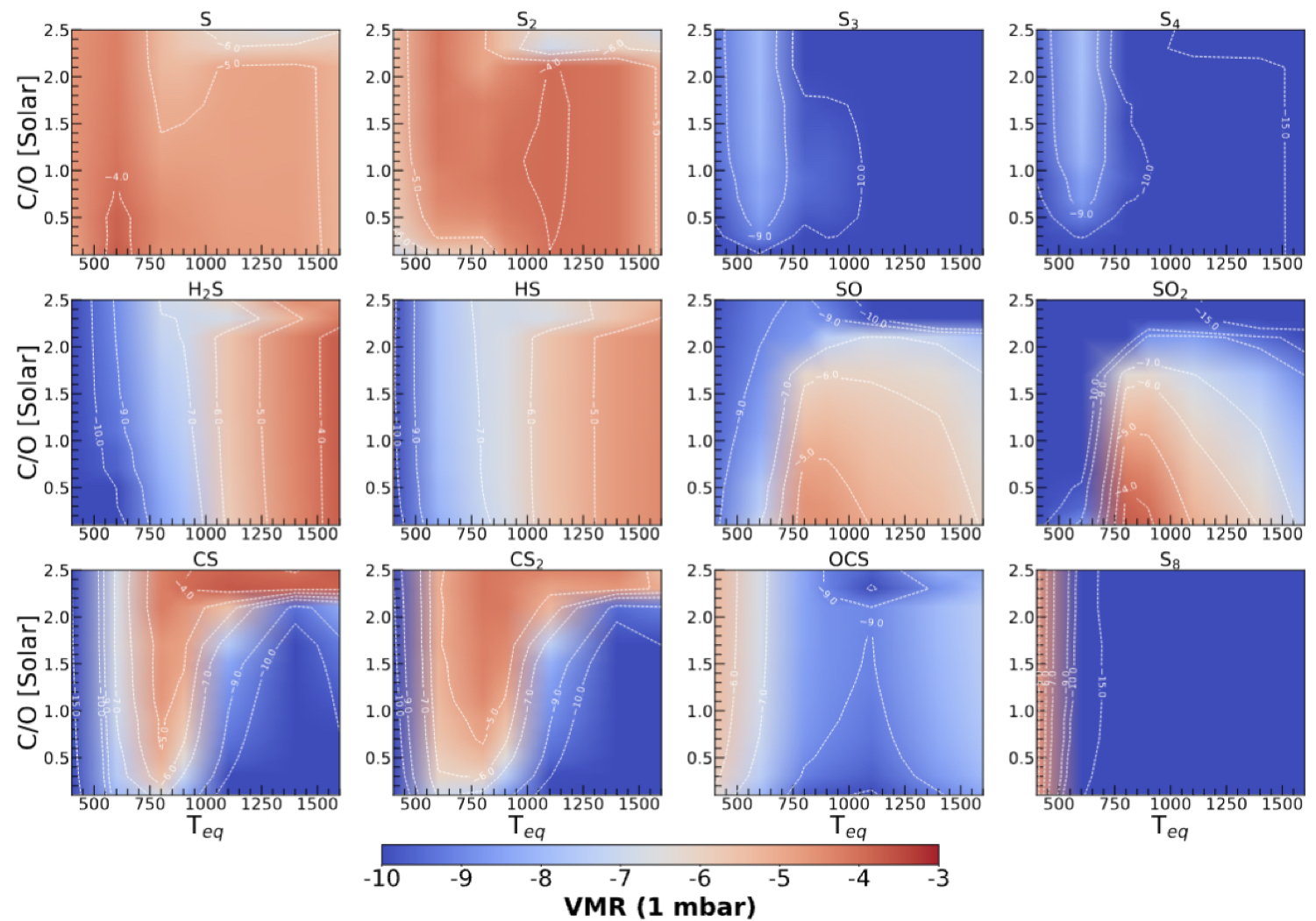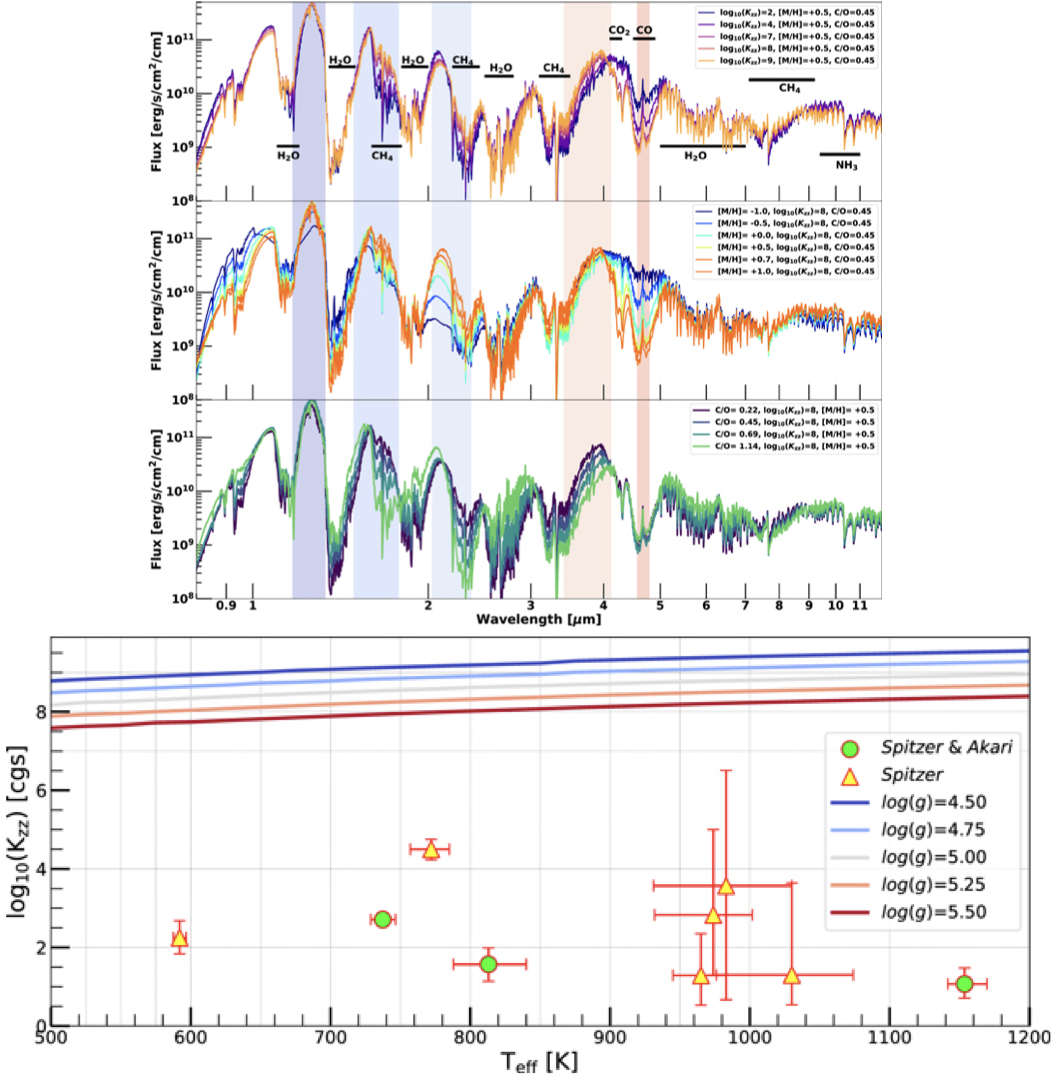Exoplanet Atmospheres

Exoplanets are planets that orbit stars other than our Sun- worlds beyond our solar system. Like the planets here at home, many exoplanets can host atmospheres, which we study using several observational techniques. When starlight passes through a planet's atmosphere on its way to us, it carries information about the atmosphere's physical state and chemical composition. Analyzing this filtered starlight spectroscopically- known as transit spectroscopy- has been one of the most powerful tools for revealing the makeup of exoplanetary atmospheres. Planets also emit their own thermal radiation, set by their temperature. Detecting this thermal emission through techniques such as direct imaging and eclipse spectroscopy allows us to probe their atmospheric structure and energy balance. In addition, some starlight is reflected off a planet's atmosphere. Studying this reflected light, or reflection spectroscopy, offers another complementary view of atmospheric properties. My research focuses on developing theoretical models of exoplanet and brown dwarf atmospheres. These models can simulate transmission spectra, thermal emission spectra, reflected-light spectra, and even polarization signatures. They are openly available through the PICASO repository. I use these tools to identify the best ways to measure atmospheric compositions and properties across a diverse range of worlds, including gas giants, sub-Neptunes, and brown dwarfs. By combining modeling with observations from space- and ground-based facilities such as JWST, HST, Keck, and Gemini, I work to explain and interpret the data, uncovering the physics and chemistry that shape these distant atmospheres. If you also find yourself wondering about the nature of these faraway worlds, their atmospheres, and what they can teach us, I would love to connect!
Cloudy Mornings and Clear Evenings on giant Exoplanet WASP-94A b

WASP-94A b is almost a Saturn-mass planet with a size that is even bigger than Jupiter. We have used JWST/NIRISS to obtain a transmission spectrum of WASP-94A b, revealing a striking atmospheric asymmetry between its morning and evening terminators. The morning terminator is completely filled with aerosols, exhibiting no molecular absorption, while the evening terminator is relatively clear, displaying prominent water vapor absorption features. While recent studies have detected chemistry- and temperature-driven asymmetries between planetary terminators (Espinoza et al. 2024, Nature; Murphy et al. 2024, Nature Astronomy; Ehrenreich et al. 2020, Nature), this is the first direct evidence of aerosol compositional differences between the two terminators. Our observations definitively show that condensed clouds, rather than photochemically formed hazes, dominate WASP-94A b's atmosphere- a long-standing open question in the field. We find that cloud particles are lofted to unusually high altitudes on the morning side but evaporate in the hotter evening terminator. This measurement enables us to determine the planet's cloud circulation pattern, providing strong constraints on temperature gradients across the limbs and on key, previously uncertain, cloud circulation timescales. Moreover, we find that this cloud-driven asymmetry introduces significant biases in the planet's inferred chemical compositions, exceeding 4-sigma level discrepancies! Our work demonstrates that probing such cloud-driven asymmetries is crucial not only for constraining the least understood aspects of cloud and circulation physics in exoplanetary atmospheres but also for accurately determining their chemical compositions, which is key to understanding their formation and evolution. The paper is under review but a preprint can be found Mukherjee et al. (2025b). We have also found in a second follow-up paper that these limb asymmetries are not limited to this one particular hot Jupiter but are common in the sample of hot Jupiters observed with JWST in transmission. Our study finds that typically the morning limb transit spectra of these tidally locked hot Jupiters planets appear to have muted transmission spectra due to aerosols and the evening limbs appear relatively clear, just like WASP-94A b. This further confirms that inhomogeneous aerosol coverage (clouds in WASP-94A b's case) is very common in hot Jupiter atmospheres and can help us probe aerosol cycling and atmospheric dynamics in unprecedented detail. WASP-94A b is the benchmark planet of this cloudy/clear asymmetry which is common but not universal among all hot Jupiters. Notably, cooler and lower gravity planets seem to show weaker asymmetry, presenting a new mystery on what drives such morning/evening weather differences across different tidally locked exoplanets. The published paper can be found here Fu, Mukherjee et al. (2025, ApJL). Our findings on atmospheric asymmetries in a sample of hot Jupiter spectra are crucial for astronomers and astrobiologists working to refine composition analysis and habitability assessments of smaller terrestrial and sub-Neptune exoplanets, where partial cloud coverage could obscure key biosignatures and bias abundance measurements (e.g., JWST observations of TRAPPIST-1 e or K2-18 b).
JWST's view of GJ 436b's Atmosphere: a Neptune-like exoplanet

GJ 436b is a Neptune-like exoplanet in terms of its mass and radius. However, its temperature is a lot warmer (~700 K) than Neptune. Past studies with telescopes like Spitzer had found that it's atmosphere is potentially poor in a gas like methane and more enriched in a gas like carbon monoxide than theoretical expectations. This is a tell-tale sign of disequilibrium chemistry in a planet's atmosphere. It was hypothesized that the interior of this Neptune-like planet is tidally heated due to its eccentric orbit. This heating of its atmosphere is reflected in this unexpected chemical composition due atmospheric dynamics. To test this hypothesis, I led a study of its atmosphere with JWST with the MANATEE collaboration. We observed the planet's eclipse with JWST to measure its panchromatic thermal emission spectrum for the first time between 2.4-12 microns. Surprisingly, we found that the JWST measurements of the planet's emission flux were totally inconsistent with the past Spitzer measurements at 3.6 and 4.5 microns (top left figure). We detect a weak evidence for the presence of carbon dioxide in GJ 436b's atmosphere with the JWST spectrum (bottom left figure). We also put stringet upper limits on the planet's albedo. We show that the JWST spectrum doesn't necessarily demand a planet with a tidally heated interior and can be explained with a nominal interior heat if cloudless conditions are assumed. Our atmospheric modeling shows that the atmosphere is likely very enriched in "metals" and it is also quite likely that the dayside of the planet is enshrouded with thick aerosol cover. More JWST observations (e.g., transmission spectrum) are required to put more stringent constraints on its composition and cloud cover. The published paper is Mukherjee et al. (2025, ApJL).
Disequilibrium Chemistry in Transiting Exoplanets: a Family Potrait of Sulfur Molecules

The chemical composition of transiting exoplanets can be significantly altered due to atmospheric processes like atmospheric dynamics, photochemistry, and interior heat flux from the planet. In this work, we have done a theoretical survey of a large parameter space to investigate how each of these processes alter the observable chemistry of diverse exoplanetary atmospheres - from gas giants to sub-Neptunes and from hot to warm planets. We have found fascinating trends in chemical behavior for gases like methane, carbon monoxide, carbon dioxide, etc. We have found that a gas that can be good tracer of the vigor of vertical mixing for one type of exoplanets can become completely insensitive to it in another. Similar trends were also found for other important planet properties like internal heat flux of planets. Sulfur molecules have been at the forefront of exoplanetary atmosphere studies since 2023 as gases like sulfur dioxide are formed in the upper atmosphere of giant planets due to photochemistry- opening up the possibility of probing sulfur in exoplanets and also probing photochemical processes. The left plot shows a fascinating behavior of sulfur bearing gases we have uncovered. We have found that gases like sulfur dioxide are prominent sulfur bearers for warm to hot exoplanets. But for colder planets, gases like carbon disulfide and carbon sulfide become the dominant sulfur bearing gases produced by photochemical processes. Moreover, atomic sulfur also are always the most dominant sulfur bearing gas for the photosphere of planets across all temperatures. To see a lot more fascinating theoretical chemical trends of exoplanets, see the published paper Mukherjee et al. (2025, ApJ). Our efforts to test these predictions with JWST observations of diverse exoplanet atmospheres is also well underway. We have reported some initial observed trends in this paper Fu et al. (2025, ApJ).
Disequilibrium Chemistry in Directly Imaged Exoplanets and Brown Dwarfs: the Sonora Elf Owl model grid

The chemical composition of directly imaged exoplanets and brown dwarfs can also be significantly altered due to highly uncertain atmospheric processes like atmospheric dynamics. In this work, we have developed a grid of radiative-convective models with self-consistent treatment of vertical mixing induced disequilibrium chemistry across a large range of object temperature, gravity, metallicity, and elemental abundance ratios. We call this the Sonora Elf Owl grid of models. We have shown that processes like vertical mixing and parameters like object metallicity have degenerate effects on various chunks of the observable spectrum of these planets and brown dwarfs (top left panels). Atmospheric dynamics is one of the least understood processes in the atmosphere of exoplanets and brown dwarfs. The parameter describing it is uncertain by 7-8 orders of magnitude. We use our theoretical model grid to constrain this highly uncertain parameter for a sample of field brown dwarfs with different temperatures. We use archival observational spectrum from Spitzer and AKARI telescopes to derive constraints on the strength of vertical mixing in their atmosphere. The bottom left figure shows our constraints. Surprisingly, we find that the strength of dynamics in their atmospheres are much weaker than expected from convection. With more self-consistent forward model grids, we show that this is likely because we are probing the strength of vertical mixing in sandwiched radiative regions in the deep atmosphere of these objects instead of convective regions. This is consistent with the theoretical predictions from my previous work in Mukherjee et al. (2023, ApJ) and the findings of Miles et al. (2020, ApJ). See the full published paper Mukherjee et al. (2024, ApJ). The models can be found in L-type, Y-type, and T-type .
Blazars

Black holes feed on the matter in their surroundings. Infalling matter on the black hole loose their gravitational energy through radiation forming disk like structures called accretion disks. These accretion disks have been spectroscopically inferred in many solar mass black hole and AGN (SMBH) systems. Blazars are black hole systems where the jet outflows from the BH points at a very small angle to our line of sight. Blazars emit across a huge range of wavelengths from radio to very high energy gamma rays. Blazars also show time variability in various timescales - from hours to years. Modeling Spectral energy distribution (SED) of blazars show that the emission in blazars are from ultra-relativistic particles which are traveling at speeds very close to the speed of light. These particles emit radiation through processes like Synchroton and Inverse- Compton radiation. Accretion disks also show variability in a large number of timescales. The origin of these highly relativistic jet outflows are not well understood. Since they originate very close to the central engine and the only source of matter in that region is the matter in the accretion disk, it is thought that the matter around the accretion disk gets accelerated and collimated as a jet through complex processes. If this is so, one might expect to observe certain temporal connection between the variability of accretion disks and jets. Chatterjee et al. (2009) and several other studies have observed such connections in Seyferts. Disk variability also is well known to show a characteristic timescale related with black hole mass observed by McHardy et al (2005) . Recently, Chatterjee et al. (2018) observed a similar characteristic timescale in jet variability as well. This raises a question and the opportunity to investigate the connections between these two timescales. We have performed numerical modeling of emission variability in the jet as well as the disk. We are investigating various scenarios of a disk-jet connection. We have also predicted the nature of Power Spectral Densities of future multi-wavelength jet variabilty observations. Here is our recent publication on the the disk-jet connection in blazar.